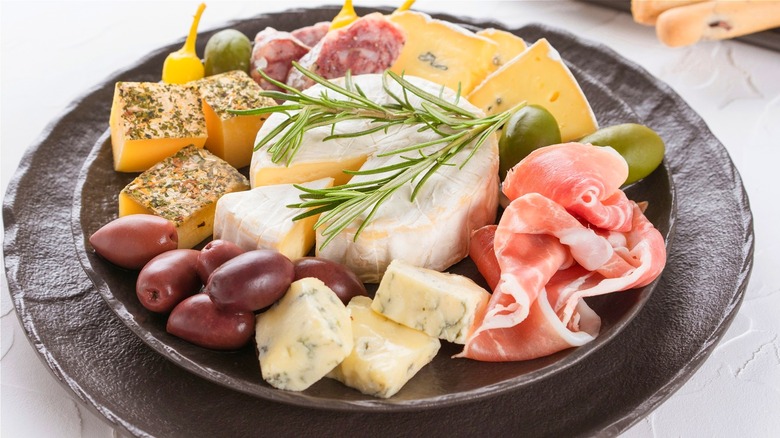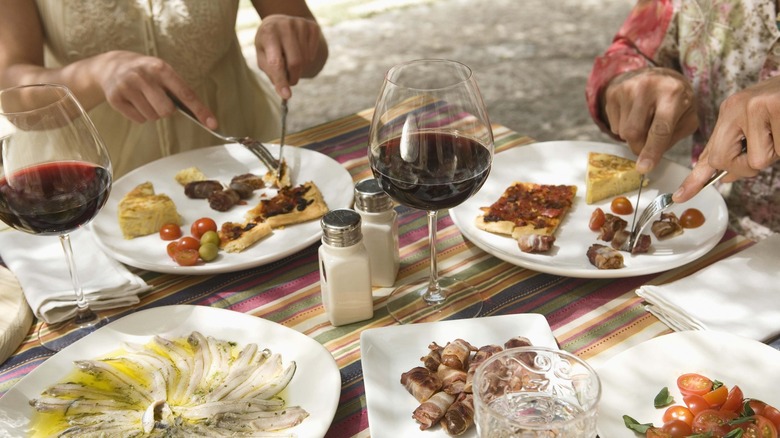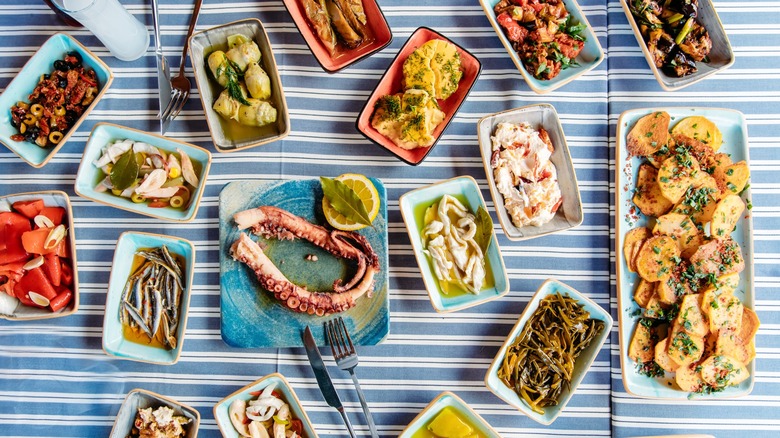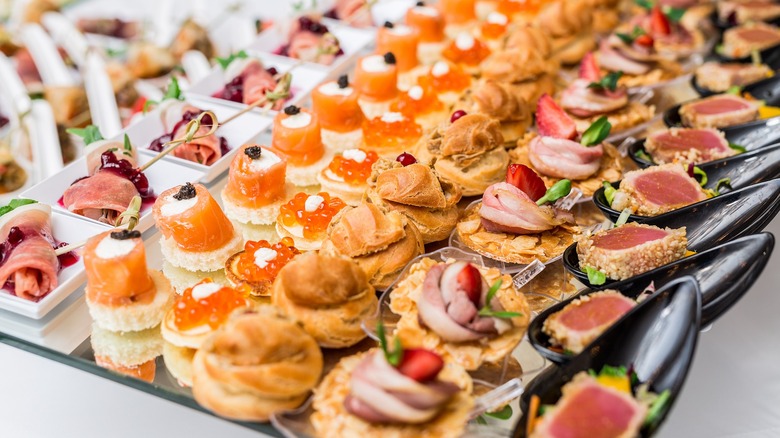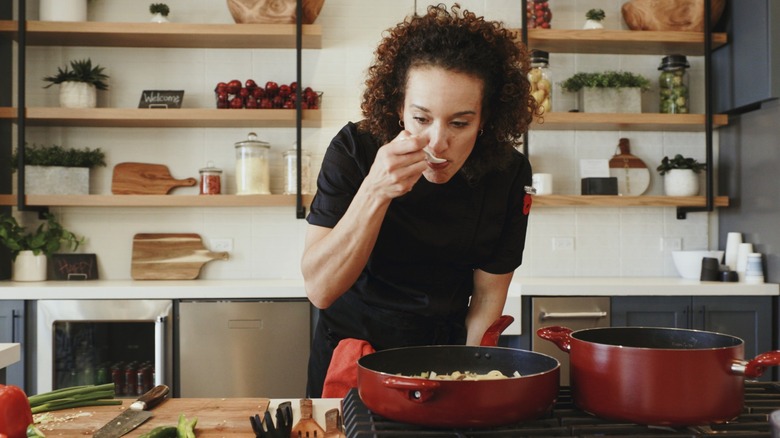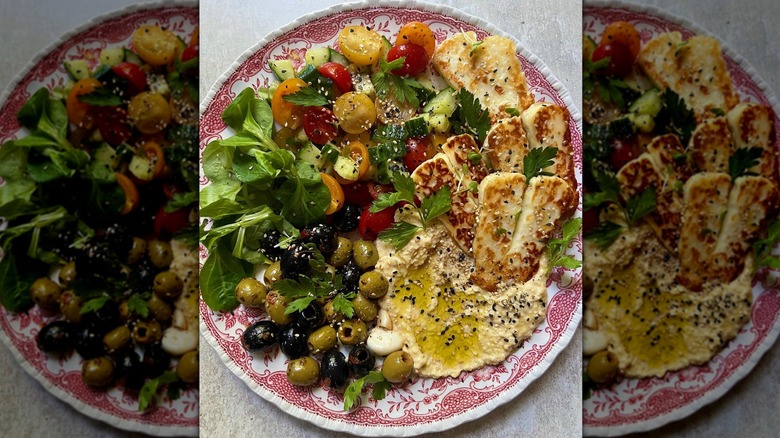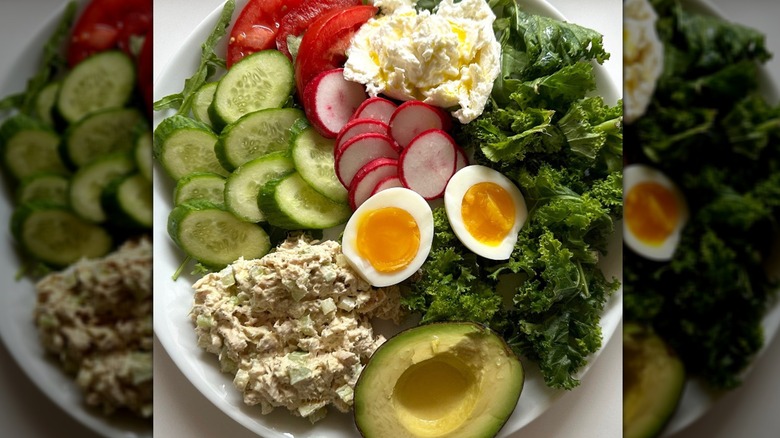Europeans Have Basically Been Doing 'Girl Dinner' For Years
The "Girl Dinner" trend arrived on the scene back in May 2023 when content creator Olivia Maher posted a TikTok of her dinner as a kind of joke — a plate of bread, cheese, cornichons, and grapes — likening it to what a peasant would eat. Soon after, the trend began to take off. To date, the hashtag "girldinner" has garnered 1.3 billion views on TikTok alone.
The trend started off with people — mostly women — sharing attractive, curated videos of their dinners. Charcuterie boards were featured heavily, with arrays of cured meats, fruit, and cheeses alongside other snacks. Soon, people were sharing videos of all kinds of takes on the trend, from cans of corn and bowls of ramen to fried chicken, as Girl Dinner descended into a "whatever's in the fridge or cupboard" meal.
But putting together a few ingredients on a plate isn't a new trend — and it certainly wasn't born on TikTok. Europeans have been preparing these types of meals for hundreds of years. From Greek meze to Spanish tapas to Italian antipasti, snacky dinners have been around for a while. We'll dive deep into the Girl Dinner trend — and take a look at some of the controversy surrounding it — and explore the trend's roots in Europe.
Girl Dinner has been a thing in Europe for a while
Different European cuisines have been doing the Girl Dinner thing for hundreds, possibly even thousands, of years. Across Europe, platters of picky bits — a term used commonly in the United Kingdom to refer to nibbles or antipasto-type snacks — are found in several countries. Each culture has a slightly different take on the trend.
Head for Spain, and you'll find tapas: small dishes designed for sharing. In Italy, antipasti platters of cured meats, cheese, olives, and other delights are everywhere. Greece and Turkey are home to the meze, where small plates of hot and cold food are brought to the table for sharing with friends and family, with dips featuring heavily. Even outside of Europe, you'll find picky bits — just look at dim sum. In China, this meal tradition consists of small dishes — such as steamed or fried dumplings, buns, and duck pancakes — that are shared with everyone at the table.
The Girl Dinner trend might seem like something new and innovative. But the concept of creating a plate of snacks from what you already have on hand isn't anything new.
Italian antipasti has a long history
Antipasto — and its plural, antipasti — is a term that roughly translates to "before the meal," from Latin. The element of smoked and cured meats in antipasto has existed for a long time, with Romans curing sausages since around 300 A.D. Vinegar — another common element in pickled antipasto dishes — began to be used as a preservative for food from around the 10th century.
A typical Italian antipasti platter contains salty foods such as pickles, olives, cheeses, marinated vegetables, cured meat, and smoked fish. The salty food is used to whet the appetite for the meal to come. In Italy, antipasti platters are traditionally served as a starting course to stimulate the appetite, so they usually aren't too filling.
Antipasti has become a meal in itself, in many cafes, bars, and even at home. It's acceptable to enjoy a platter of cured meat, cheeses, olives, and pickles with some bread for dinner, perhaps alongside a glass or two of wine. Many Girl Dinners are inspired by this Italian antipasto tradition, incorporating the exact same snacks into their meals.
Spanish tapas was around long before Girl Dinner
Whether you've been to Spain, dined at a tapas restaurant, or have zero knowledge of tapas, chances are you've eaten some of these small Spanish dishes designed for sharing at some point. Dishes like patatas bravas, croquetas, and albondigas have become common worldwide.
The tradition of tapas has pretty murky origins. The word "tapa" means "lid" in Spanish. One origin story plays off of this translation; it tells that a bartender once used a slice of bread — with some ham and cheese on it — to cover drinks left on the bar, as a way to keep flies and dust out of the drink. Another origin story involves Spanish King Alfonso XIII. In the early 20th century, the king's physician prescribed he drink a lot of wine while recovering from illness, and alongside, he ate various small dishes of food. He eventually recovered from illness, but continued the trend of eating small dishes with his alcoholic beverages.
Tapas are traditionally served as an appetizer, or small snack before dinner or lunch, and this holds true nowadays. However, many Spanish people also enjoy tapas as a full meal. Tapas has clearly been around for a lot longer than the Girl Dinner Trend. However, you could easily put together a delicious Girl Dinner consisting of classic tapas dishes.
Greek meze has ancient roots
Greek meze is a tradition that consists of small dishes that make up the meal. With this storied European culinary custom, a variety of salads, dips, and cooked dishes are served for everybody at the table to share. Greek meze was around long before anybody even considered the Girl Dinner trend. It's first referenced in Homer's "The Odyssey." However, it's more generally believed to have been brought to Greece by the Persian invasion of the country around the 5th century B.C.
The word meze may have Persian or Turkish roots, coming from the Persian word "mazzeh" meaning "taste" or the Turkish word "meze," which means "appetizer." Meze dishes are traditionally served with Greek or Turkish spirits, such as raki or ouzo. Popular dishes include hummus, dolmades (stuffed vine leaves), spanakopita (cheese and spinach pie), keftedes (lamb meatballs), gigantes plaki (giant baked beans), and horiatiki (Greek salad).
Greek or Turkish meze bear a strong resemblance to the casual, whatever's-in-the-fridge vibe associated with the Girl Dinner trend. However, meze is traditionally designed to feed a crowd rather than a solo diner. There's nothing to stop you from whipping up some popular Greek meze dishes for your Girl Dinner, though. Some Greek meze dishes have already been featured in others' Girl Dinners.
French hors d'oeuvres date back to the 17th century
French hors d'oeuvres — an expression meaning "outside the work" — dates back to the 17th century. The tradition evolved from another type of French appetizer known as "entremets," which translates to "between servings." These were typically small, savory snacks served to the French upper class between courses. As entremets evolved into hors d'oeuvres, they began to be served as canapes — small pieces of bread with savory toppings — before the main meal. When they became popular in the United States, they were served throughout the meal to refresh the palate.
Some examples of classic hors d'oeuvres include smoked salmon blinis, bite-size tarts, and foie gras on toast. The mix-and-match nature of hors d'oeuvres makes it easy to put together a few bites from whatever is in your fridge for a solo dinner.
You may hear hors d'oeuvres referred to as appetizers, but in the U.S., appetizers are usually the first course of a multi-course meal. While you wouldn't typically serve hors d'oeuvres as a main course, it's easy to put together a spread of them for a party, so why not for a Girl Dinner?
Cooking for one has always been a thing
At its heart, the Girl Dinner trend is all about making dinner for yourself. Yet cooking for one — or preparing a dinner with bits from your fridge or cupboard — is nothing new. Antipasti, tapas, and other simple meals consisting of small plates have been popular in Europe for a long time. So why is Girl Dinner taking off now?
Perhaps one reason the Girl Dinner trend has gone viral is the fact that cooking for one has become more of a thing recently. According to the U.S. Census Bureau, around 50% of Americans over 18 years old are currently single. While that doesn't necessarily mean they live alone, it does mean that there's a huge chunk of the population out there that may be cooking for one.
There's no shortage of inspiration out there for solo cooks and diners. Cookbooks like Klancy Miller's "Cooking Solo: The Fun of Cooking for Yourself" and Joanie Zisk's "The Ultimate Cooking for One Cookbook" are packed with speedy recipes for those eating alone. Yet those who are working full time and have other commitments like childcare or housework might not always feel like cooking, which is where the Girl Dinner trend comes in.
Sometimes it feels like there just aren't enough hours in the day, and from that perspective, the Girl Dinner trend's popularity makes sense. Why spend your evenings over a stove, making dinner for yourself, when you could just assemble a plate of tasty bites that don't require cooking?
The trend is now hitting restaurant menus
With the Girl Dinner trend gaining popularity, it was only a matter of time before restaurants cashed in on the trend. Though there are already European restaurants out there offering hors d'oeuvres, tapas, or meze, Popeyes went one step further with the introduction of its Girl Dinner Menu.
The special menu was only available on the restaurant brand's website and consisted solely of sides to order individually. The idea was to combine your choice of sides to create your own Girl Dinner. However, this menu doesn't currently appear to be on the Popeyes website at the time of writing.
There were plenty of sides to choose from, too, so you could create a fairly well-balanced meal — or, as well-balanced as any meal at Popeyes can be, anyway. Sides on the Girl Dinner menu included coleslaw, Cajun fries, macaroni and cheese, mashed potatoes, red beans and rice, and biscuits.
Popeyes' Girl Dinner didn't actually introduce anything new, as all these sides were previously available. It was a smart way for the brand to lure in customers, but that's about it.
Some say that Girl Dinner promotes disordered eating
Even though similar eating habits have existed in numerous European cultures for years, some people claim that the Girl Dinner trend is potentially toxic. They think it may encourage people to take up disordered eating habits. Critics claim that because the trend invites comparison between people's meals — many of which are smaller than what you'd expect from a typical dinner — this could lead some social media users to question their own food consumption. In other cases, this could lead to food and calorie restriction.
Several nutritionists and health experts have spoken out against the Girl Dinner trend, saying that it could be unhealthy in some cases. They advise against following social media accounts that make followers feel shameful, guilty, or like they need to eat less, after viewing Girl Dinner-type posts.
If you need help with an eating disorder, or know someone who does, help is available. Visit the National Eating Disorders Association website or contact NEDA's Live Helpline at 1-800-931-2237. You can also receive 24/7 Crisis Support via text (send NEDA to 741-741).
The trend has some positives
While plenty of people have spoken out against Girl Dinner, we believe there can be positive outcomes from the trend. Firstly, it provides the opportunity to try some of the many small plate dishes from Greek, Italian, French, Spanish, and other European cultures which have been making their own types of Girl Dinners for years.
Second, Girl Dinner provides women with the opportunity to break from cooking — for themselves or others — and it even celebrates this idea. Additionally, the trend provides another way for women to put their own needs first, by letting them curate a plate of some of their favorite foods. This lets them eat what they want to eat — regardless of whether those foods are considered traditionally "healthy" or not.
Also, a study published in the journal PubMed suggests that eating lighter meals in the evenings may actually be better for your blood sugar metabolism. Girl Dinner could even help reduce food waste, as you're gathering items from your fridge and cupboard that may soon expire and using up any leftovers.
Then there's the camaraderie aspect. Across TikTok and social media, #girldinner has brought women of all ages, races, and backgrounds together, allowing them to bond over food. This also gives people the opportunity to be inspired by what other people are putting together on their Girl Dinner plates.
You can make your own nutritious Girl Dinner
How can you put together your own healthy Girl Dinner? Charcuterie, olives, and cheeses are delicious, but there are a few things to remember when you want to create a well-balanced spread.
Don't forget to take your inspiration from the Europeans who have been eating like this throughout history. Dips are a delicious way to do so. Be inspired by Greek meze dips like hummus and tzatziki. As an accompaniment, feel free to try making Spanish patatas bravas or other tapas dishes that are plant-based.
You can also include raw fruits and vegetables — they will make your plate as colorful as it is nourishing. Veggies like carrots, peppers, and cucumber make great accompaniments to the dips you select. All of these dishes can help to create a Girl Dinner that borrows from delicious European traditions while providing you with a nutritious meal.
